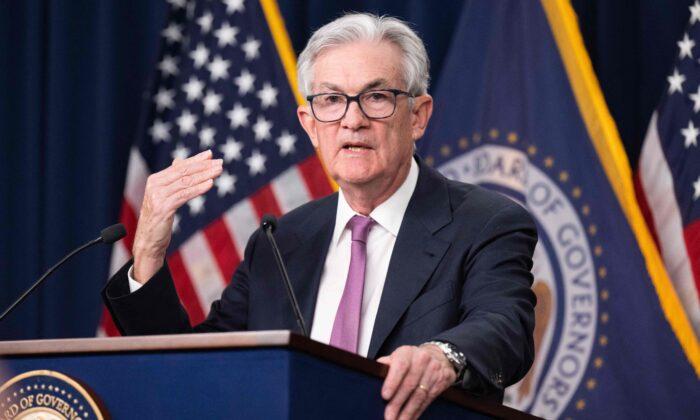The Federal Reserve raised interest rates by 25 basis points, lifting the benchmark federal funds rate to a range of 4.75–5.0 percent, the highest since late 2007. This is the ninth consecutive rate increase by the Fed in the past year to combat inflation.
Fed officials say that the banking system is “sound and resilient” and that the recent developments “are likely to result in tighter conditions for households and businesses,” which could weigh on economic activity, hiring, and inflation levels.
Fed projections show that there will be one more quarter-point rate hike this year and cuts totaling 75 basis points in 2024.
The FOMC statement signaled that it could be finished with rate hikes soon, as officials removed the phrase “ongoing increases” from this month’s announcement.
Although the Fed’s balance sheet has experienced an expansion over the past week, the rate-setting FOMC confirmed that it will continue reducing its holdings of Treasurys, mortgage-backed securities, and agency debt.
According to the Survey of Economic Projections (SEP), the Fed funds rate is expected to be 4.3 percent next year, up from the previous December estimate of 4.1 percent. Officials see the policy rate at 3.1 percent, unchanged from December. The longer-run rate also stayed the same, at 2.5 percent.
“The committee anticipates that some additional policy firming may be appropriate in order to attain a stance of monetary policy that is sufficiently restrictive to return inflation to 2 percent over time,” the committee stated. “In determining the extent of future increases in the target range, the committee will take into account the cumulative tightening of monetary policy, the lags with which monetary policy affects economic activity and inflation, and economic and financial developments.”
While speaking to reporters in his post-FOMC meeting press conference, Fed Chair Jerome Powell confirmed that rate cuts this year aren’t the central bank’s baseline expectation.
The economic projections, Powell noted, suggest that committee participants expect slow growth, a gradual rebalancing of supply and demand in the labor market, and inflation moving down.
“If that happens, participants don’t see rate cuts this year. I just don’t,” Powell stated. “I would just say, as always, the path of the economy is uncertain, and policy is going to reflect what actually happens really what we write down the SEP, but that’s not our baseline expectation.”
Although the Fed is predicting one more rate hike this year, Powell confirmed that if officials need to raise rates, they will.
The Fed revised its gross domestic product (GDP) projections, lowering the growth rate to 0.4 percent from 0.5 percent this year. The Fed also adjusted its real GDP forecast for 2024, to 1.2 percent from 1.6 percent. The SEP also revised its 2025 GDP growth rate, to 1.9 percent from 1.8 percent.
The unemployment rate is seen rising to 4.6 percent by 2025, up from the December prediction of 4.5 percent.
On the inflation front, the Personal Consumption Expenditures (PCE) price index is predicted to slow to 3.3 percent in 2023, up from the December projection of 3.1 percent. PCE inflation is still expected to ease to 2.5 percent in 2024 and 2.1 percent in 2025.
Core PCE inflation was revised slightly higher, to 3.6 percent this year and 2.6 percent in 2024. Core inflation is expected to slow to 2.1 percent in 2025, unchanged from the December SEP.
U.S. financial markets plummeted before the closing bell on March 22, as the Dow Jones Industrial Average plummeted more than 400 points. The S&P 500 and the Nasdaq composite index each tumbled more than 1 percent.
The benchmark 10-year yield fell to 3.45 percent.
The U.S. Dollar Index, which gauges the dollar against a basket of currencies, tanked roughly 0.8 percent, to about 102.45.
“If the financial system remains stable, this likely isn’t the last rate hike. The Fed remains focused on raising rates to get inflation under control. But if another shoe drops and conditions deteriorate, the question becomes how soon the Fed will reverse course and begin cutting rates—aggressively,” said Greg McBride, chief financial analyst at Bankrate.
Did the Fed Need to Cut Rates Instead?
Since the start of the banking crisis, only a small number of economists and prominent market personalities have suggested that the Fed needed to slash interest rates to support the financial system.In response to a tweet by hedge fund manager Bill Ackman, who said the central bank needed to pause, Tesla Motors and Twitter CEO Elon Musk advocated for a cut.
Only one bank, Nomura Securities, supported Musk’s recommendation.
The Fed should begin cutting interest rates immediately, according to Bryce Doty, the senior vice president and senior portfolio manager at Sit Investment Associates.
“The Fed can cut rates and immediately reverse some of the damage,” Doty wrote in a note on March 20. He also wrote that many of today’s challenges could have been avoided if the Fed had recognized inflation earlier.
“Instead of raising rates slowly and cease printing trillions of dollars when the economy first reopened, the Fed didn’t begin raising rates until a year ago after year-over-year inflation had surpassed 7 percent,” he said.
Some experts have argued that the Fed no longer needs to be aggressive in the current hiking cycle, alluding to slowing inflation.
In February, the consumer price index (CPI) eased to 6.0 percent, and the core CPI slowed to 5.5 percent.





